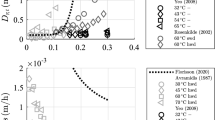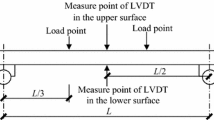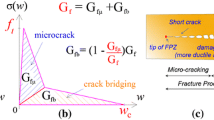Abstract
In a combined experimental, numerical, and analytical approach, damage onset and propagation in unidirectional and cross-laminated samples from European beech due to climatic changes are studied. The inter- and intra-laminar damage evolution is characterized for various configurations, adhesively bonded by three structural adhesive systems. Different lamella thicknesses are studied to capture size effects. Typical situations are simulated by means of a comprehensive moisture-dependent nonlinear rheological finite element model for wood with the capability to capture delaminations. The simulations give insight into the role of different strain components such as viscoelastic, mechano-sorptive, plastic, and hygro-elastic deformations under changing moisture content in progressive damage and delamination. The stress buildup under cyclic hygric loading was shown, resulting in hygro-fatigue. It was demonstrated that a modified analytical micro-mechanics of damage model, originally developed for cross-ply laminates, can be employed to describe the problem of moisture-induced damage in beech lamellae.

















Similar content being viewed by others
References
ABAQUS (2014) ABAQUS Documentation v. 6.14. Simulia. © Dassault Systèmes
Alfano G, Crisfield MA (2001) Finite element interface models for the delamination analysis of laminated composites: mechanical and computational issues. Int J Numer Methods Eng 50(7):1701–1736
Ammann S, Schlegel S, Beyer M, Jung H, Niemz P (2016) Quality assessment of glued ash wood for construction engineering. Eur J Wood Prod 74:67–74
de Borst R, Gutiérrez MA, Wells GN, Remmers JJC, Askes H (2004) Cohesive-zone models, higher-order continuum theories and reliability methods for computational failure analysis. Int J Numer Methods Eng 60(1):289–315
DIN EN 14080 (2013) Timber structures: glued laminated timber and glued solid timber: requirements; German version, DIN German Institute for Standardization
Fortino S, Mirianon F, Toratti T (2009) A 3D moisture-stress FEM analysis for time dependent problems in timber structures. Mech Time-Depend Mater 13(4):333–356
Fortino S, Zagari G, Mendicino AL, Dill-Langer G (2012) A simple approach for FEM simulation of Mode I cohesive crack growth in glued laminated timber under short-term loading. J Struct Mech 45(1):1–20
Gereke T (2009) Moisture-induced stresses in cross-laminated wood panels. PhD thesis, ETH Zurich
Hass P, Wittel FK, McDonald SA, Marone F, Stampanoni M, Herrmann HJ, Niemz P (2010) Pore space analysis of beech wood: the vessel network. Holzforschung 64(5):639–644
Hass P, Mendoza M, Wittel FK, Niemz P, Herrmann HJ (2012a) Inverse determination of effective mechanical properties of adhesive bondlines. Eur J Wood Prod 70:785–790
Hass P, Wittel FK, Mendoza M, Herrmann HJ, Niemz P (2012b) Adhesive penetration in Beech wood. Wood Sci Technol 46(1–3):243–256
Hass P, Wittel FK, Niemz P, Herrmann HJ (2013) Generic failure mechanisms in adhesive bonds. Holzforschung 67(2):207–215
Hassani MM, Wittel FK, Hering S, Herrmann HJ (2015) Rheological model for wood. Comput Methods Appl Mech 283:1032–1060
He MY, Evans AG, Hutchinson JW (1994) Crack deflection at an interface between dissimilar elastic materials: role of residual stresses. Int J Solids Struct 31(24):3443–3455
Hering S (2011) Characterization and modeling of material properties of beech wood for simulation of glued-laminated wood, PhD Thesis ETH No. 19903
Kläusler O, Clauß S, Lübke L, Trachsel J, Niemz P (2013) Influence of moisture on stress–strain behaviour of adhesives used for structural bonding of wood. Int J Adhes Adhes 44:57–65
Liu S, Nairn JA (1990) Fracture mechanics analysis of composite microcracking: experimental results in fatigue. In: Proceedings of the 5th technical conference on composite materials american society of composites, East Lansing, Michigan, June 11–14, pp 287–295
Mendoza M, Hass P, Wittel FK, Niemz P, Herrmann HJ (2012) Adhesive penetration of hardwood: a generic penetration model. Wood Sci Technol 46(1–3):529–549
Nairn JA (1989) The strain energy release rate of composite microcracking: a variational approach. J Compos Mater 23(11):1106–1129
Nairn JA, Hu S (1992) The initiation and growth of delaminations induced by matrix microcracks in laminated composites. Int J Fract 57(1):1–24
Nairn JA, Hu S (1994) Micromechanics of damage: a case study of matrix microcracking. In: Talreja R (ed) Damage mechanics of composite materials (Chapter 6), composite material series 9. Elsevier Science, Amsterdam, pp 187–243
Qiu LP, Zhu EC, van de Kuilen JWG (2014) Modeling crack propagation in wood by extended finite element method. Eur J Wood Prod 72(2):273–283
River BH (2003) Fracture of adhesive-bonded wood joints. In: Pizzi A, Mittal KL (eds) Handbook of adhesive technology, revised and expanded, 2nd edn. Taylor & Francis, London
Serrano E (2000) Adhesive joints in timber engineering: modelling and testing of fracture properties. Technical report TVSM-1012, PhD thesis Lund University
Serrano E (2004) A numerical study of the shear-strength-predicting capabilities of test specimens for wood–adhesive bonds. Int J Adhes Adhes 24(1):23–35
Silva M, de Moura M, Morais J (2006) Numerical analysis of the ENF test for mode II wood fracture. Compos Part A-Appl S 37(9):1334–1344
Simon F, Valentin G (2003) Cohesive failure characterisation of wood adhesive joints loaded in shear. ESIS Publ 32:305–316
Touati D, Cederbaum G (1997a) Stress relaxation of nonlinear thermoviscoelastic materials predicted from known creep. Mech Time-Depend Mater 1(3):321–330
Touati D, Cederbaum G (1997b) On the prediction of stress relaxation from known creep of nonlinear materials. J Eng Mater Technol 119(2):121–124
Volkmer T, Schmidt JA, Kranitz K, Niemz P (2012) Studies on the influence of the type of adhesive on the diffusion resistance of wood adhesives. Bauphysik 34(2):55–60
Wimmer R, Kläusler O, Niemz P (2013) Water sorption mechanisms of commercial wood adhesive films. Wood Sci Technol 47(4):763–775
Wittel FK, Kun F, Kröplin BH, Herrmann HJ (2003) A study of transverse ply cracking using a discrete element method. Comput Mater Sci 28(3–4):608–619
Wittel FK, Dill-Langer G, Kröplin BH (2005) Modeling of damage evolution in soft-wood perpendicular to grain by means of a discrete element approach. Comput Mater Sci 32(3–4):594–603
Zhang X, et al (2005) Comprehensive hygro-thermo-mechanical modeling and testing of stacked die BGA module with molded underfill. In: Proceedings of the 55th electronic components and technology conference (Lake Buena Vista, FL) 1:196–200
Acknowledgments
This work was funded by the Swiss National Science Foundation in the National Research Programme NRP 66—Resource Wood under Grant No. 406640-140002: Reliable timber and innovative wood products for structures.
Author information
Authors and Affiliations
Corresponding author
Rights and permissions
About this article
Cite this article
Hassani, M.M., Wittel, F.K., Ammann, S. et al. Moisture-induced damage evolution in laminated beech. Wood Sci Technol 50, 917–940 (2016). https://doi.org/10.1007/s00226-016-0821-5
Received:
Published:
Issue Date:
DOI: https://doi.org/10.1007/s00226-016-0821-5




